 Before the outbreak of the First World War, Romania consisted of three principal regions: Wallachia, Moldavia, and Dobruja. The first two were characterized by a predominantly Romanian population, whereas Dobruja exhibited a notable degree of ethnic heterogeneity, with a significant Muslim population and a Romanian minority. Beyond Romania’s borders, several territories, namely Bessarabia, Southern Bukovina, and Transylvania, also harbored substantial Romanian populations. The central aspiration of Romanian nationalists during this period was the unification of these regions under a single Romanian state, in which the Romanian language would serve as the dominant linguistic and cultural medium.
Before the outbreak of the First World War, Romania consisted of three principal regions: Wallachia, Moldavia, and Dobruja. The first two were characterized by a predominantly Romanian population, whereas Dobruja exhibited a notable degree of ethnic heterogeneity, with a significant Muslim population and a Romanian minority. Beyond Romania’s borders, several territories, namely Bessarabia, Southern Bukovina, and Transylvania, also harbored substantial Romanian populations. The central aspiration of Romanian nationalists during this period was the unification of these regions under a single Romanian state, in which the Romanian language would serve as the dominant linguistic and cultural medium.
![]() During the early years of the war, despite the presence of pro-French, pro-British, and pro-Russian sentiments within the country, Romania adopted a policy of armed neutrality. Both the Central Powers and the Entente sought to draw Romania into their respective alliances by offering promises of territorial expansion. The Central Powers proposed the annexation of Bukovina and Bessarabia, territories that would be taken from Tsarist Russia, whereas the Entente promised Transylvania, to be separated from the Austro-Hungarian Empire.
During the early years of the war, despite the presence of pro-French, pro-British, and pro-Russian sentiments within the country, Romania adopted a policy of armed neutrality. Both the Central Powers and the Entente sought to draw Romania into their respective alliances by offering promises of territorial expansion. The Central Powers proposed the annexation of Bukovina and Bessarabia, territories that would be taken from Tsarist Russia, whereas the Entente promised Transylvania, to be separated from the Austro-Hungarian Empire.
Romania ultimately decided to align itself with the Entente on 17 August 1916, and ten days later formally declared war on the Central Powers. Following this declaration, the country mobilized a force of approximately 750,000 soldiers along the northern Carpathian Mountains and the southern frontier, reflecting its commitment to the newly established alliance.

In pursuit of a rapid victory, Romanian troops advanced across the Austro-Hungarian border, successfully occupying a considerable portion of Transylvania. This offensive enabled them to threaten the Austro-Hungarian defensive lines in the Carpathians from an unanticipated direction. In response, the German High Command not only sought to defend Austro-Hungarian territories but also identified an opportunity to eliminate Romania as a military power, thereby securing a strategic advantage in Eastern Europe.
The ensuing German military plan was executed with precision as a coordinated double encirclement. The Austro-Hungarian Fourth Army was tasked with engaging Romanian forces in the north, while General Erich von Falkenhayn’s German Ninth Army advanced southward toward the Romanian capital, Bucharest. Concurrently, a newly constituted Danube Army composed of German, Bulgarian, and Ottoman troops under the experienced leadership of Field Marshal August von Mackensen was organized to launch a northward offensive through the Dobruja region.
The Road to Romania

The decision to deploy Ottoman forces for a joint campaign in Romania represented a calculated and deliberate strategic move, one that had been anticipated in light of previous Ottoman troop movements in Galicia. The units selected for participation in the Romanian campaign comprised the VI Corps, commanded by General Hilmi Pasha; the 15th Division, under the leadership of Lieutenant Colonel Hamdi Bey; and the 25th Division, commanded by Colonel Şükrü Ali Bey. Notably, Enver Pasha had issued directives for these forces to prepare for mobilization even prior to Romania’s formal declaration of war.
 The Ottoman contingents designated for the Romanian expedition assembled in Edirne and Bakırköy, a district of Istanbul. The operational plan stipulated that the 25th Division would be transported to Pravade, while the 15th Division would proceed to Varna. Ultimately, both divisions were to converge at Dokuzağaç, the designated rendezvous point of the VI Corps, strategically located in central Dobruja, approximately fifty kilometers north of the Romania–Bulgaria border. This careful deployment reflected a high degree of strategic foresight and coordination in preparation for the forthcoming campaign.
The Ottoman contingents designated for the Romanian expedition assembled in Edirne and Bakırköy, a district of Istanbul. The operational plan stipulated that the 25th Division would be transported to Pravade, while the 15th Division would proceed to Varna. Ultimately, both divisions were to converge at Dokuzağaç, the designated rendezvous point of the VI Corps, strategically located in central Dobruja, approximately fifty kilometers north of the Romania–Bulgaria border. This careful deployment reflected a high degree of strategic foresight and coordination in preparation for the forthcoming campaign.

Within the complex framework of wartime strategy, Field Marshal August von Mackensen meticulously devised his offensive operations, originally scheduled to commence on 1 September 1916. However, the execution of these plans was impeded by significant logistical challenges, most notably the poor condition of the railway network in northern Bulgaria. These difficulties delayed the arrival of the Ottoman units at the front. It was not until 4 September that the 75th Regiment of the 25th Division reached Pravade, marking the beginning of their movement toward the operational area. Despite these constraints, the entrainment and deployment of the Ottoman forces proceeded with notable efficiency, and by 19 September, they were fully positioned and prepared for combat operations.

The Ottoman forces’ first engagement in Romania took place on 24 September. The 25th Division, positioned with Bulgarian cavalry on its right flank and the Bulgarian 6th Division on its left, received orders to launch an assault on the town of Amuzaca. At precisely 9:15 a.m., the offensive commenced with the opening of artillery fire, signaling the beginning of the Ottoman contingent’s active participation in the Romanian campaign.
By 3:00 p.m., the 75th Regiment had successfully penetrated and secured the town of Amuzaca, demonstrating considerable tactical proficiency and discipline. Following this accomplishment, Colonel Şükrü Ali Bey dispatched a telegram to General Toshev, the Bulgarian commander, proposing a continued northward advance to exploit the momentum of success. However, this proposal was ultimately declined, and the Ottoman forces were instead instructed to consolidate their territorial gains and establish a fortified defensive position.
![]() Concurrently, the 74th Regiment endured a sustained and intense Romanian counterattack, during which it suffered significant losses. The cumulative toll on the 25th Division by the end of the engagement was severe with 415 soldiers killed, 2,226 wounded, and 893 reported missing in action. Although the Ottoman forces emerged tactically victorious, the heavy casualties rendered the triumph pyrrhic, underscoring the harsh realities and devastating human cost inherent to the modern battlefield.
Concurrently, the 74th Regiment endured a sustained and intense Romanian counterattack, during which it suffered significant losses. The cumulative toll on the 25th Division by the end of the engagement was severe with 415 soldiers killed, 2,226 wounded, and 893 reported missing in action. Although the Ottoman forces emerged tactically victorious, the heavy casualties rendered the triumph pyrrhic, underscoring the harsh realities and devastating human cost inherent to the modern battlefield.

Recognizing that their rapid incursion into Transylvania had been a strategic miscalculation, one that exposed their positions to Mackensen’s advancing forces, the Romanian High Command sought to reclaim the initiative through a coordinated counteroffensive in Dobruja. Under the leadership of General Averescu, the Romanians organized the Southern Group of Armies and initiated a long-planned offensive on 1 October, striking simultaneously across both the Dobruja and Danube fronts.
In Dobruja, the Romanian attack was directed primarily against the Ottoman 25th Division, which had been reinforced by the recently arrived 15th Division. Following a day of fierce combat, Ottoman forces managed to maintain their defensive positions, preventing the Romanian troops from advancing beyond a distance of two kilometers from the entrenched lines. A counteroffensive was planned to be launched during the night; however, heavy snowfall severely disrupted communications between the Ottoman units, ultimately preventing the execution of the intended counterattack.

Across the rugged terrain of Dobruja, an intense and protracted battle raged for seven consecutive days. The Ottoman 25th Division composed of the steadfast 56th, 59th, and 75th Regiments formed a cohesive and resilient front line extending approximately ten kilometers. Despite demonstrating considerable bravery, the Romanian forces suffered significant losses, with 812 soldiers killed, 2,893 wounded, and 952 reported missing in action.
The morale of the Ottoman troops, however, remained exceptionally high. Their confidence was buoyed not only by their successful defense against repeated Romanian assaults but also by the arrival of General Hilmi Pasha, who assumed overall command of the operation. The situation was further strengthened by the full combat readiness of the 15th Division, which provided much-needed reinforcement. Amidst the chaos of the Dobruja front, these developments set the stage for a potentially decisive shift in the course of the campaign.
Meanwhile, on the Danube front, Romanian forces executed an audacious attempt to cross the river between Totrakan and Russe. Despite the boldness of this maneuver, the subsequent offensive quickly faltered, forcing the Romanian troops to withdraw and return to their initial positions. The events on both fronts illustrated the strategic complexity and fluctuating fortunes that characterized this critical phase of the conflict.
Renewed Offensive
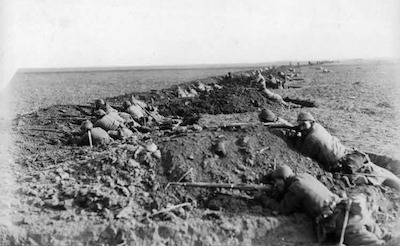
A profound sense of disappointment permeated the Romanian ranks, creating the conditions for Field Marshal Mackensen’s decisive counterstroke. The experienced commander methodically reorganized the theater of operations into two distinct sectors, deploying his forces with calculated precision. The Eastern Group was placed under the command of Bulgarian General Kantarchiev, while General Toshev assumed command of the Western Group, which included the Ottoman VI Corps. Mackensen’s overarching strategy was to engage and fix the enemy’s position, sever potential lines of retreat with the Western Group, and execute a concentrated assault on the left flank with the Eastern Group, thereby encircling and destroying the Romanian forces.
At dawn on 19 October 1916, Mackensen’s plan was set into motion in accordance with his meticulous operational design. The Ottoman regiments, demonstrating exceptional resilience and determination, successfully repelled the Romanian advance guards during the opening engagements. Within a span of merely three days, Ottoman forces achieved a remarkable breakthrough, dismantling Romanian defensive positions, advancing approximately twenty kilometers, and fulfilling their designated tactical objectives with notable efficiency.
Confronted with the realization that the strategic position at Cobadin could no longer be maintained, Romanian forces rapidly altered their course of action. Certain units retreated across the Danube in search of safety on its western bank, while those remaining east of the river commenced a withdrawal northward, closely pursued by the advancing Ottoman VI Corps. The ensuing operations transformed the Dobruja front into a dynamic and fluid battlefield, where every maneuver and counter-maneuver contributed to shaping the broader trajectory of the conflict.

On the morning of 24 October, the northward advance of the Ottoman forces was brought to an abrupt halt following the receipt of direct orders from General Toshev to General Hilmi Pasha. The new directive instructed the Turkish units to redirect their movement westward toward the town of Chernovoda, strategically located along the banks of the Danube. Acting with efficiency and discipline, the Ottoman forces promptly executed this maneuver, reaching the river the following day and effectively encircling the Romanian contingents that had not yet managed to cross to the opposite bank. By 27 October, the offensive had reached its culmination: the Ottoman VI Corps had advanced deep into Romanian territory, while Bulgarian forces successfully secured the narrow corridor of Dobruja between the Black Sea and the Danube. The cost of this achievement, however, was considerable as the Ottoman VI Corps sustained 1,864 fatalities, 7,720 wounded, and 2,020 soldiers reported missing, reflecting the high human toll exacted by the campaign.
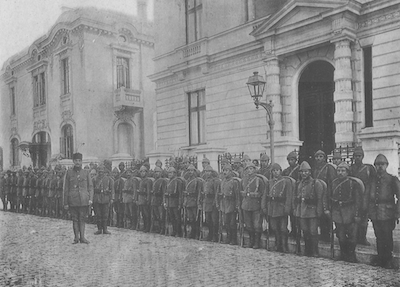
Mackensen’s subsequent strategic design envisioned the Western Group comprising the Ottoman VI Corps, the German 217th Division, and the Bulgarian 1st Division crossing the Danube to link up with the forces advancing northward through Wallachia. This coordinated movement was intended to deliver a decisive and final blow to the Romanian army. However, this meticulously prepared plan encountered a major impediment when intelligence reports indicated that Romanian forces in Dobruja had been significantly reinforced, with additional Russian units en route to strengthen their defensive positions.

Adopting a defensive posture, the Ottoman VI Corps fortified its positions, establishing well-entrenched defensive lines to withstand further enemy advances. On 17 November, Russian forces succeeded in outflanking the Bulgarian positions and launched an offensive against the Ottoman lines. Despite the intensity of the assault, the attack was repelled, and renewed offensives on 1 and 3 December met with the same outcome. The Ottoman troops, demonstrating remarkable endurance and discipline, held their positions firmly. The situation shifted decisively on 8 December, when the Ottoman forces assumed the initiative. Over the course of approximately ten days, they conducted a series of successful counteroffensives, steadily pushing back Russian formations, regaining lost ground, and advancing roughly fifty kilometers. Their progress brought them to commanding positions overlooking the Danube Delta, culminating in the capture of the town of Isecca on the river’s banks by a rapidly advancing cavalry detachment.
Seeking to complete the encirclement of the Romanian forces, Field Marshal Mackensen requested the cooperation of the Ottoman contingents. In accordance with new operational directives, the Ottoman units were ordered to pivot southward toward the Danubian town of Harsovo. Yielding the recently recovered territory to Bulgarian control, the Ottoman troops commenced their southward march. On the first day of the new year, 1917, following a grueling fifteen-day march covering more than two hundred kilometers under severe winter conditions, the 15th Division and the VI Corps headquarters began their crossing of the Danube. The 25th Division followed shortly thereafter, arriving on 11 January and initiating its own river crossing one week later.
More Turkish Troops to Romania
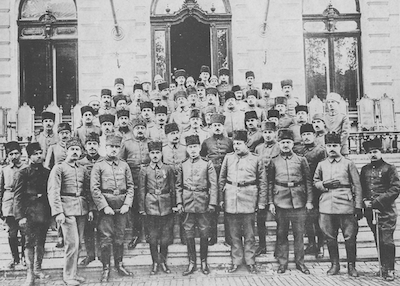
Recognizing the critical necessity of reinforcing the Ottoman front, Field Marshal Mackensen promptly requested the deployment of additional Turkish forces to sustain the momentum of operations in Romania. Responding decisively to this call, Enver Pasha and the Ottoman High Command resolved to dispatch an additional division to the Romanian theater. The selected unit was the 26th Division, a well-organized formation composed of the 73rd, 76th, and 78th Regiments, under the command of Lieutenant Colonel Hamdi Bey. With this reinforcement, the total strength of the Ottoman contingent operating in Romania increased to approximately thirty-nine thousand troops, significantly enhancing its operational capacity and strategic importance within Mackensen’s multinational command structure.

On 9 November 1916, the Ottoman 26th Division commenced its deployment from Edirne, beginning a critical phase of its journey to the Romanian front. After traversing challenging terrain, the division reached Sistova and successfully crossed the Danube River on 25 November. Upon arrival, it was seamlessly integrated into Field Marshal Mackensen’s Danube Army, which also included the German 217th Infantry Division and a German cavalry division. United under this multinational command, the Ottoman troops advanced northeastward toward Bucharest. Meanwhile, General Erich von Falkenhayn’s German Ninth Army proceeded on a coordinated southward and eastward offensive through Wallachia, as the Austro-Hungarian First Army sought to subdue Romanian resistance entrenched in the Carpathian Mountains.
On 27 November 1916, in the rugged vicinity of the town of Marzanesti, the Ottoman 26th Division engaged Romanian forces in its first major confrontation. The engagement concluded with a clear Ottoman victory, enabling the division to maintain its advance toward its strategic objectives. At the same time, in the sphere of reconnaissance, Field Marshal August von Mackensen detected indications of an impending Romanian counteroffensive targeting the Danube Army. Demonstrating his characteristic strategic foresight, Mackensen assigned the Ottoman 26th Division and the accompanying German cavalry units to defend the army’s exposed flanks, ensuring the security and cohesion of his operational front.
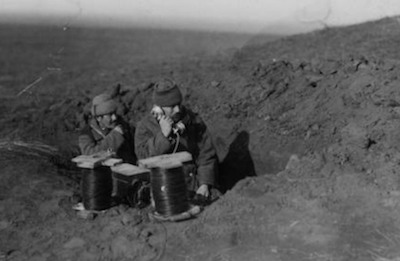
The Romanian offensive commenced on 1 December 1916. Along the Tarnovo–Draganesti road, the steadfast Ottoman 73rd Regiment engaged the enemy in fierce combat, while the accompanying German cavalry sought to halt the Romanian advance in the Lestanau sector. Confronted by the superior strength of the Romanian forces, Lieutenant Colonel Hamdi Bey demonstrated tactical acumen by deploying the 76th Regiment to reinforce the embattled front. After a day of intense and protracted fighting, the Romanian troops were compelled to relinquish control of Tarnovo and retreat in a strategic withdrawal. This confrontation constituted a pivotal moment in the advance toward Bucharest, though it came at a considerable cost to the Ottoman forces. 87 soldiers were killed, 524 wounded, and 357 reported missing in action.
The following day, the Ottoman 78th Regiment spearheaded the capture of the village of Balaria, serving as the central force behind this success. With this victory, the path to Bucharest was effectively opened, and by 4 December, the forces of Falkenhayn and Mackensen successfully linked up. Only four days later, on 8 December, their troops entered Bucharest in triumph, with the Ottoman 78th Regiment proudly participating in the victory parade through the city’s streets.

In the aftermath of Bucharest’s fall, Romanian forces conducted a northward retreat, closely pursued by Mackensen’s Danube Army. The Ottoman 26th Division, held in reserve, followed in close support. On 16 December, Enver Pasha personally inspected the division at Balasiul, reviewing its condition after the arduous campaign.
Romanian resistance subsequently consolidated along the Gurgueti–Romanul–Tisileşti line, successfully impeding further advances by the Danube Army. Meanwhile, the Ottoman VI Corps and the 15th Division, having crossed the Danube on 1 January 1917, joined the Danube Army, further strengthening the multinational force.
On the night of 4–5 January, General Averescu ordered a strategic withdrawal north of the Sereth River. In response, General Hilmi Pasha, now commanding a corps composed of three Ottoman divisions, issued directives for a coordinated assault the following day. The 15th and 26th Divisions were tasked with attacking north of Ibrail, a strategically located town along the Sereth River. Although the Ottoman forces succeeded in capturing the commanding heights overlooking the river, they encountered stiff resistance from the defending forces. The ensuing engagements resulted in a stalemate, prompting both the Ottoman troops and the Danube Army to fortify their positions south of the Sereth. Although only limited Romanian and Russian forces remained in the area, their persistent resistance continued to frustrate Mackensen’s command and hinder further offensive operations.

On 26 March 1917, orders reverberated through the ranks of the Ottoman 26th Division, instructing its redeployment back to Istanbul. The division commenced its return journey from Bucharest on 1 April, progressing steadily over the following weeks and completing its entrainment by the end of the month. For the remainder of the year, the Romanian theater experienced relative calm; minor skirmishes occurred in August and September, but they constituted only peripheral disturbances in the broader operational landscape. Thus, the Romanian campaign effectively drew to a close.
Subsequently, on 30 September, the Ottoman 25th Division received similar instructions for return. Executing the entrainment with efficiency, the division arrived back in Istanbul on 4 January 1918. The Ottoman High Command had briefly considered dispatching the 46th Division as a replacement, but this plan was ultimately abandoned.
Meanwhile, the headquarters of the VI Corps and the 15th Division maintained their positions along the Danube until April 1918. At the onset of May, these units embarked from the port of Constanta, navigating the Black Sea toward Batumi for a new operational assignment—deployment against Russian forces in the challenging terrain of the Caucasus.
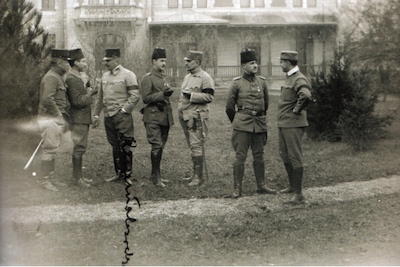
Throughout the Eastern Front during the First World War, Ottoman forces played a crucial role in supporting the Central Powers, particularly within the arduous Romanian theater. Ottoman troops faced both Romanian and Russian forces, demonstrating not only courage but also remarkable reliability under extreme operational conditions. Their endurance and combat effectiveness were especially valued by Field Marshal Mackensen, who relied on their capacity to conduct prolonged and strenuous marches under harsh winter conditions.
Two Ottoman divisions maintained continuous deployment on Romanian soil for eighteen months, while a third division remained for a full two years. Despite this extended presence, the actual duration of active combat engagement totaled approximately five months. During these periods of intense fighting, the divisions incurred significant casualties. In March 1917, as Ottoman forces advanced toward the Sereth River, their total strength numbered around 21,000 personnel; yet, the cumulative casualties rose dramatically to 18,000.
This historical assessment underscores a poignant realization: these seasoned and battle-hardened divisions, distinguished by their endurance and sacrifice, may have been more strategically employed in other theaters of critical importance, notably Mesopotamia and Palestine. Nevertheless, their operations in Romania constitute a compelling narrative of resilience, dedication, and martial effectiveness, leaving an enduring legacy across the complex and challenging landscapes of the Eastern Front.
![]()
PAGE LAST UPDATED ON 19 OCTOBER 2025